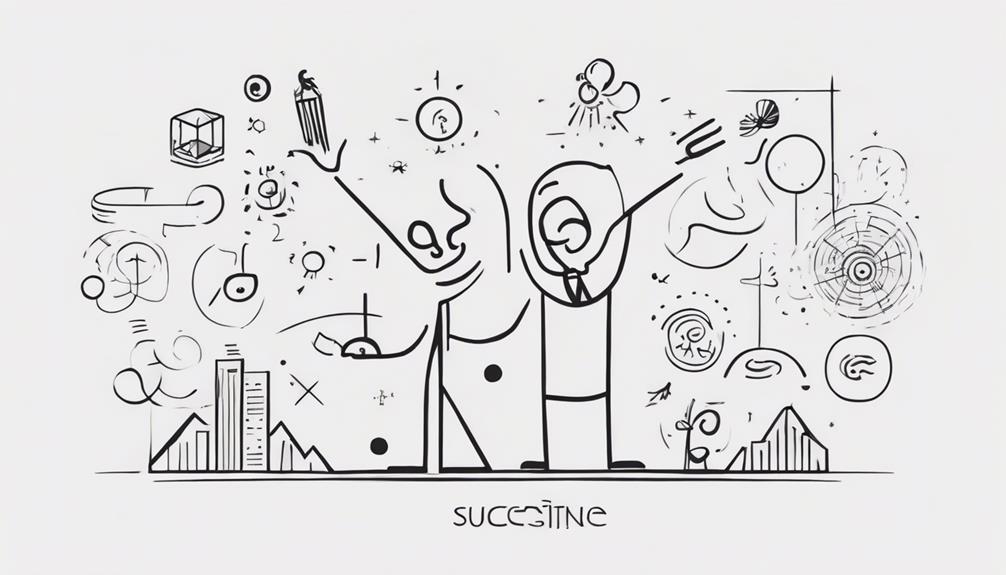Achieving a balance between ambition and contentment is a complex endeavor that requires a nuanced approach. The interplay between striving for greater heights and finding peace in the present moment is a perpetual challenge for many individuals seeking personal fulfillment. By exploring the cognitive processes behind ambition and contentment, we can uncover strategies to harmonize these seemingly conflicting forces. Stay tuned to unravel the intricate dynamics of balancing ambition with contentment and discover practical techniques to navigate this intricate terrain.
Key Takeaways
- Cultivate self-awareness to align ambitions with personal values.
- Embrace intrinsic motivations for sustainable contentment.
- Practice gratitude and mindfulness to reduce ambition-induced stress.
- Set realistic goals that balance personal growth with present moment satisfaction.
Understanding Your Ambition Drivers

When seeking to understand your ambition drivers, it is crucial to discern whether they stem from intrinsic motivations or external validation. Ambition, as a driving force behind human behavior, can be influenced by various factors. Intrinsic motivations refer to internal desires, values, and passions that propel individuals towards their goals. These ambitions are often rooted in personal growth, fulfillment, or a genuine interest in the pursuit itself. On the other hand, external validation-driven ambitions are fueled by the need for approval, recognition, or rewards from others.
Understanding your ambition drivers involves reflecting on how your personal values and beliefs shape your aspirations. It also requires evaluating the impact of societal norms and expectations on the level of ambition you hold. Furthermore, considering how past experiences and upbringing have molded your ambitions is essential in gaining insight into your driving forces. By aligning your ambitions with your long-term goals and aspirations, you can ensure that your pursuit of success is meaningful and fulfilling.
Embracing the Present Moment
Embracing the present moment entails actively engaging with one's current experiences, fostering a state of mindfulness. By practicing mindfulness, individuals can enhance their awareness and appreciation of the beauty and opportunities that exist in the now. Letting go of concerns about the past or future allows individuals to focus on the present and cultivate feelings of contentment and satisfaction.
Mindful Appreciation Techniques
Utilizing mindful appreciation techniques enhances contentment by directing focus towards the present moment, fostering a sense of fulfillment and alleviating ambition-induced stress.
Key Points:
- Present Moment Awareness: Mindfulness practices encourage focusing on the current experience rather than future ambitions, promoting a deeper appreciation for life's blessings.
- Gratitude Cultivation: Practicing gratitude for what one has now helps strike a balance between ambition and contentment by fostering feelings of fulfillment and reducing the drive for constant achievement.
- Mindfulness Exercises: Engaging in activities like deep breathing or meditation can aid in reducing feelings of inadequacy driven by ambition, leading to increased levels of contentment and satisfaction.
Gratitude Practice Daily
Practicing daily gratitude serves as a powerful tool for embracing the present moment, fostering contentment, and enhancing overall well-being. Research indicates that gratitude practice can significantly boost happiness and well-being by encouraging individuals to focus on the present rather than solely on future ambitions. Studies have shown that engaging in gratitude exercises on a daily basis can effectively reduce stress levels, increase positive emotions, and improve mental health by instilling a sense of contentment and fulfillment. Furthermore, regular gratitude practice is linked to enhanced relationships and greater overall life satisfaction, as it shifts individuals' focus towards appreciating current blessings rather than constantly striving for future accomplishments. Embracing gratitude daily can thus play a vital role in achieving a harmonious balance between ambition and contentment.
Identifying Areas for Growth

To enhance personal growth, it is crucial to identify areas in need of improvement through reflection on individual goals and feedback from others. Evaluating strengths and weaknesses allows for a targeted approach towards progress, while self-reflection aids in uncovering opportunities for advancement. By understanding where growth is necessary, individuals can focus their efforts on achieving personal development goals and finding fulfillment.
Personal Development Goals
In the pursuit of personal development goals, individuals can effectively identify areas for growth by conducting a thorough assessment of their strengths and weaknesses. This introspective process provides a foundation for setting meaningful objectives and fostering self-improvement. To enhance personal development effectively, consider the following:
- Set Specific Goals: Define clear and achievable objectives for self-improvement.
- Align with Long-Term Aspirations: Focus on developing skills and qualities that resonate with your overarching life goals.
- Establish Measurable Milestones: Create a detailed plan with quantifiable checkpoints to monitor progress systematically.
Seeking New Opportunities
By engaging in deliberate self-reflection, individuals can strategically identify areas ripe for personal growth and improvement. Seeking new opportunities for learning and development is essential to expand skills and knowledge. By assessing one's current situation, it becomes possible to pinpoint areas where challenges can lead to growth. Embracing change and stepping out of the comfort zone are crucial steps in exploring new possibilities for advancement. Staying open to feedback and constructive criticism allows for continuous improvement and evolution in the journey towards balancing ambition and contentment. It is through this process of seeking new opportunities that individuals can push themselves towards greater personal and professional development, ultimately achieving a harmonious blend of ambition and contentment in their lives.
Finding Inner Fulfillment
Building upon the foundation of seeking new opportunities for growth, the path to finding inner fulfillment begins with a thorough examination of one's strengths and weaknesses to identify key areas for personal development. In this process, it is essential to focus on setting realistic goals and creating a roadmap for self-improvement. To achieve inner fulfillment, individuals should consider the following:
- Reflect on Strengths and Weaknesses: Understanding where you excel and where you have room for improvement is crucial for personal growth.
- Explore Different Aspects of Life: Identify areas in your personal and professional life that can be enhanced to bring about a sense of fulfillment.
- Set Specific Goals: Establish specific, measurable, achievable, relevant, and time-bound goals aligned with your values to drive purposeful growth.
Setting Attainable Goals

Achieving success in personal endeavors hinges on the strategic establishment of attainable goals, which serve as the foundation for sustained motivation and progress. Setting attainable goals involves defining specific, measurable objectives that can be realistically achieved. By breaking down larger ambitions into manageable steps, individuals can maintain motivation and focus on their journey towards meaningful work. Goals that are challenging yet feasible encourage growth and progress while avoiding overwhelm. When establishing attainable goals, it is crucial to consider personal strengths, available resources, and time constraints to ensure they are within reach. Tracking progress towards these goals not only provides a sense of accomplishment but also reinforces motivation for continued success. Below is a table illustrating the key aspects of setting attainable goals:
| Aspects | Description |
|---|---|
| Specific and Measurable | Clearly defined objectives that can be quantified and tracked. |
| Challenging Yet Feasible | Goals that push individuals to grow while remaining achievable. |
| Considerate of Resources | Taking into account personal strengths and available support systems. |
| Progress Tracking | Monitoring advancements towards goals to stay motivated and focused. |
Evaluating Goal Size Appropriateness
When evaluating the appropriateness of goal size, one must carefully consider the resources and time required for its successful attainment, ensuring alignment with personal values, interests, and capabilities for a purposeful pursuit.
Key Considerations:
- Resource Allocation: Assess the resources, such as time, money, and skills, needed to achieve the goal. Ensure that the goal is realistically attainable within the available means.
- Personal Alignment: Evaluate if the goal resonates with your values, interests, and strengths. A goal that aligns with these aspects is more likely to be fulfilling and sustainable in the long run.
- Impact Assessment: Consider the potential effects of pursuing the goal on your overall well-being and relationships. Ensure that the pursuit of the goal does not compromise your mental, emotional, or social health.
Cultivating Self-Discipline

Cultivating self-discipline is a fundamental practice essential for harmonizing ambition with contentment, enabling individuals to navigate the pursuit of goals with purpose and consistency. Self-discipline serves as the cornerstone for achieving a balance between striving for success and finding satisfaction in the present. By setting clear objectives and adhering to them, individuals can align their actions with their ambitions while also fostering contentment along the way. Research indicates that those with high levels of self-discipline are more likely to succeed in reaching their desired outcomes. This success stems from the ability to resist distractions, maintain focus on long-term goals, and appreciate current achievements without losing sight of future aspirations. Developing self-discipline empowers individuals to regulate their behaviors effectively, ensuring they can actively pursue their ambitions while also enjoying a sense of peace and fulfillment in the present moment. Through consistent practice and commitment to self-discipline, individuals can navigate the delicate balance between ambition and contentment with greater ease and purpose.
Overcoming Limiting Beliefs
Limiting beliefs can act as barriers to achieving a balance between ambition and contentment. By challenging self-doubt, embracing a growth mindset, and cultivating inner confidence, individuals can begin to overcome these obstacles. It is essential to recognize the impact of negative self-talk and seek support from mentors to navigate and address limiting beliefs effectively.
Challenge Self-Doubt
To confront and conquer self-doubt, it is imperative to actively challenge and reframe the limiting beliefs that impede both ambition and contentment. Self-limiting beliefs can hinder personal growth and success. Here are three key strategies to overcome self-doubt:
- Identify Negative Patterns: Recognize and acknowledge the self-limiting beliefs that hold you back.
- Reframe Negative Thoughts: Transform negative self-talk into positive affirmations to boost self-confidence.
- Practice Self-Compassion: Understand that self-doubt is a common experience, and be kind to yourself during challenging times.
Embrace Growth Mindset
Embracing a growth mindset involves actively challenging and reshaping ingrained beliefs that may hinder personal development and success. By recognizing and overcoming limiting beliefs, individuals can strike a balance between ambition and contentment. This process entails viewing challenges as opportunities for growth and learning, breaking free from self-imposed limitations, and embracing failures as valuable experiences. Research indicates that individuals with a growth mindset exhibit greater resilience, motivation, and goal achievement compared to those with fixed mindsets. To cultivate a growth mindset, individuals should engage in self-reflection, seek feedback, and welcome new challenges. By fostering a growth mindset, individuals can navigate the pursuit of ambitious goals while maintaining a sense of contentment and fulfillment.
Cultivate Inner Confidence
Individuals who actively challenge and reshape their ingrained beliefs towards personal development and success are better equipped to cultivate inner confidence and overcome self-limiting beliefs. To effectively cultivate inner confidence, consider the following:
- Challenge Negative Thoughts: Address and challenge negative beliefs that impede confidence and growth.
- Practice Positive Self-Talk: Engage in positive self-dialogue to counteract doubts and build self-assurance.
- Reframe Self-Limiting Beliefs: Recognize and reframe self-limiting beliefs to boost self-esteem and ambition.
Conducting Self-Reflection
Engaging in the practice of self-reflection allows individuals to delve into their inner thoughts and values, aiding in the exploration of the balance between ambition and contentment. Self-reflection involves introspection and evaluation of personal goals and values, providing a platform to understand the driving forces behind one's ambition and contentment. It serves as a tool to identify areas where ambition may be overshadowing contentment, enabling individuals to analyze their thoughts and actions critically. Through self-reflection, one can make informed decisions to achieve a harmonious balance between pursuing ambitions and finding contentment in the present. Regular self-reflection is key to fostering personal growth and aligning ambitions with inner contentment. By taking the time to reflect on their aspirations and satisfaction levels, individuals can gain a deeper understanding of themselves and strive towards a more fulfilling and balanced life.
Adopting Goal-Oriented Habits

Developing a habit of setting and pursuing measurable goals is essential for aligning ambition with practical outcomes. To effectively adopt goal-oriented habits, consider the following key points:
- Specificity and Measurability: Setting clear and specific goals allows for better tracking of progress and provides a roadmap for achievement, enhancing the alignment between ambition and tangible results.
- Timely Action: Creating a timeline for goal accomplishment encourages a sense of purpose and direction, fostering a feeling of progress and fulfillment that contributes to overall contentment.
- Regular Review and Adjustment: Continuously assessing and adapting goals ensures they remain relevant and attainable, promoting a balanced approach to ambition by allowing for flexibility and growth.
Finding Value and Purpose
To bridge the gap between setting goal-oriented habits and achieving a sense of fulfillment, it is vital to explore the intrinsic connection between personal values and overarching purpose. Understanding one's purpose can provide direction, align ambitions with values, and ultimately lead to a more fulfilling life. By recognizing the importance of purpose in ambition, individuals can cultivate a sense of inner peace and contentment. Finding value in meaningful pursuits is key to enhancing the balance between ambition and contentment. This alignment between personal values and purpose serves as a compass, guiding individuals towards goals that are not only achievement-oriented but also deeply fulfilling.
| Personal Values | Overarching Purpose |
|---|---|
| Integrity | Making a positive impact on society |
| Growth | Fulfilling one's potential |
| Compassion | Helping others achieve their goals |
| Creativity | Innovating and pushing boundaries |
| Resilience | Overcoming challenges and reaching new heights |
Navigating Ambition and Contentment

Achieving a harmonious equilibrium between ambition and contentment necessitates a strategic approach that acknowledges the interplay of personal aspirations and inner fulfillment. When navigating the complexities of ambition, individuals can benefit from the following insights:
- Setting Realistic Goals: Establishing achievable objectives can prevent the buildup of tension and dissatisfaction that often arises from overly ambitious pursuits. By calibrating ambitions to align with personal capacities and circumstances, individuals can foster a sense of progress without sacrificing contentment.
- Embracing Intrinsic Motivation: Cultivating gratitude and deriving motivation from internal sources rather than external validation can sustain a healthy balance between ambition and contentment. Intrinsic drivers like passion and purpose can fuel ambitions while preserving a sense of fulfillment independent of external milestones.
- Aligning Goals with Values: Recognizing personal values and ensuring that ambitions are in harmony with these core beliefs is essential for navigating the interplay between ambition and contentment. By integrating ambitions that resonate with one's values, individuals can pursue growth while maintaining a sense of purpose and satisfaction.
Frequently Asked Questions
Can Contentment and Ambition Coexist?
Contentment and ambition can indeed coexist, providing a delicate balance between fulfillment in the present and aspirations for the future. While contentment signifies satisfaction with one's current circumstances, ambition represents the drive to achieve more. By integrating these two elements, individuals can experience a sense of purpose and well-being. Recognizing the value of contentment alongside the motivation of ambition can lead to a more holistic and rewarding life journey.
What Balances Ambition?
Achieving balance in ambition involves aligning goals with values, fostering intrinsic motivation, and maintaining a sense of purpose. Recognizing personal limitations and being mindful of one's well-being are crucial in balancing ambition. By setting realistic expectations and embracing gratitude, individuals can navigate the pursuit of ambitions while staying content. Striking a harmonious blend between ambition and contentment leads to a fulfilling and satisfying life.
How Can I Control My Ambition?
Ambition management entails harnessing one's drive for personal growth and success effectively. To control ambition, individuals must cultivate self-awareness, set clear and attainable goals, and align aspirations with intrinsic motivations. Regular reflection on values and priorities, along with practicing gratitude, can help strike a balance between ambition and contentment. By focusing on internal fulfillment rather than external validation, individuals can steer their ambition towards sustainable and meaningful pursuits.
How Can I Satisfy My Ambition?
To satisfy ambition, individuals should align goals with personal values and skills, ensuring they are challenging yet achievable. Pursuing opportunities for growth, networking with supportive peers, and embracing calculated risks are vital. Continuous learning and adaptability to change enhance ambition fulfillment. Balancing ambition with contentment involves recognizing achievements, finding joy in the journey, and maintaining a healthy perspective on success. Satisfaction in ambition comes from a harmonious blend of progress and personal fulfillment.
Conclusion
In conclusion, the delicate balance between ambition and contentment requires a strategic approach to goal-setting and self-reflection. By acknowledging the desire for growth while finding satisfaction in the present moment, individuals can achieve a more fulfilling life. Ironically, it is in the pursuit of higher goals that true contentment can be found, leading to a harmonious and well-rounded existence.
